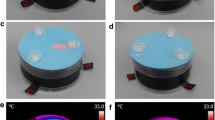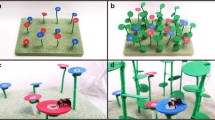Abstract
Floral colour patterns are contrasting colour patches on flowers, a part of the signalling apparatus that was considered to display shape and colour signals used by flower-visitors to detect flowers and locate the site of floral reward. Here, we show that flower-naïve bumblebees (Bombus terrestris) spontaneously direct their approach towards the outside margin of artificial flowers, which provides contrast between these dummy flowers and the background. If no floral guides are present, the bumblebees continue to approach the margin and finally touch the marginal area of the dummy flower with the tips of their antennae. Whilst approaching dummy flowers that also have a central floral guide, the bumblebees change their direction of flight: Initially, they approach the margin, later they switch to approaching the colour guide, and finally they precisely touch the floral guide with their antennae. Variation of the shape of equally sized dummy flowers did not alter the bumblebees’ preferential orientation towards the guide. Using reciprocal combinations of guide colour and surrounding colour, we showed that the approach from a distance towards the corolla and the antennal contact with the guide are elicited by the same colour parameter: spectral purity. As a consequence, the dummy flowers eliciting the greatest frequency of antennal reactions at the guide are those that combine a floral guide of high spectral purity with a corolla of less spectral purity. Our results support the hypothesis that floral guides direct bumblebees’ approaches to the site of first contact with the flower, which is achieved by the tips of the antennae.



Similar content being viewed by others
References
Biesmeijer JC, Giurfa M, Koedam D, Potts SG, Joel DM, Dafni A (2005) Convergent evolution: floral guides, stingless bee nest entrances, and insectivorous pitchers. Naturwissenschaften 92:444–450
Chittka L (1992) The colour hexagon: a chromaticity diagram based on photoreceptor excitations as a generalized representation of colour opponency. J Comp Physiol A 170:533–543
Dafni A, Giurfa M (1999) The functional ecology of nectar guides in relation to insect behaviour and vision. In: Wasser S (ed) Evolutionary theory and processes—modern perspectives. Kluwer Academic, Dortrecht, pp 363–383
Dafni A, Kevan PG (1996) Floral symmetry and nectar guides: ontogenetic constraints from floral development, colour pattern rules and functional significance. Bot J Linn Soc 120:371–377
Dafni A, M Lehrer, Kevan PG (1997) Spatial flower parameter and insect spatial vision. Biol Rev 27:239–282
Daumer K (1958) Blumenfarben, wie sie die Bienen sehen. Z Vgl Physiol 41:49–110
Dobson HEM, Bergström G (2000) The ecology and evolution of pollen odors. Plant Syst Evol 222:63–87
Giurfa M, Vorobyev M, Kevan P, Menzel R (1996) Detection of coloured stimuli by honeybees: minimum visual angles and receptor specific contrasts. J Comp Physiol A 178:699–709
Hempel de Ibarra N, Giurfa M, Vorobyev M (2001) Detection of coloured patterns by honeybees through chromatic and achromatic cues. J Comp Physiol A 187:215–224
Hempel de Ibarra N, Giurfa M, Vorobyev M (2002) Discrimination of coloured patterns by honeybees through chromatic and achromatic cues. J Comp Physiol A 188:503–512
Heuschen B, Gumbert A, Lunau K (2005) A generalised mimicry system involving angiosperm flower colour, pollen and bumblebees’ innate colour preferences. Plant Syst Evol 252:121–137
Kevan PG, Backhaus WGK (1998) Color vision: ecology and evolution in making the best of the photic environment. In: Backhaus WGK, Kliegl R, Werner JS (eds) Color vision: perspectives from different disciplines. DeGruyter, Berlin, pp 163–183
Lehrer M (1997) Honeybee’s use of spatial parameters for flower discrimination. Isr J Plant Sci 45:157–167
Lehrer M, Bischof S (1995) Detection of model flowers by honeybees: the role of chromatic and achromatic contrast. Naturwissenschaften 82:145–147
Lunau K (1990) Colour saturation triggers innate reactions to flower signals: flower dummy experiments with bumblebees. J Comp Physiol A 166:827–834
Lunau K (1991) Innate flower recognition in bumblebees (Bombus terrestris, B. lucorum; Apidae)—optical signals from stamens as landing reaction releasers. Ethology 88:203–214
Lunau K (1992) Innate recognition of flowers by bumblebees—orientation of antennae to visual stamen signals. Can J Zool 70:2139–2144
Lunau K (2000) The ecology and evolution of visual pollen signals. Plant Syst Evol 222:89–111
Lunau K, Wacht S, Chittka L (1996) Colour choices of naive bumble bees and their implications for colour perception. J Comp Physiol A 178:477–489
Manning A (1956) The effect of honey-guides. Behavior 9:114–139
Osche G (1983) Optische Signale in der Coevolution von Pflanze und Tier. Ber Dtsch Bot Ges 96:1–27
Simonds V, Plowright CMS (2004) How do bumble bees first find flowers? Unlearned approach responses and habituation. Anim Behav 67:379–386
Spaethe J, Tautz J, Chittka L (2001) Visual constraints in foraging bumblebees: flower size and color affect search time and flight behavior. Proc Natl Acad Sci U S A 98:3898–3903
Vorobyev M, Kunze J, Gumbert A, Giurfa M, Menzel R (1997) Flowers through the insect eyes. Isr J Plant Sci 45:93–102
Acknowledgements
We would like to thank A. Thorson for linguistic improvement and the members of the Sensory Ecology Group at the HHU Düsseldorf for discussion and comments.
Author information
Authors and Affiliations
Corresponding author
Electronic supplementary material
Below is the link to the electronic supplementary material.
Rights and permissions
About this article
Cite this article
Lunau, K., Fieselmann, G., Heuschen, B. et al. Visual targeting of components of floral colour patterns in flower-naïve bumblebees (Bombus terrestris; Apidae). Naturwissenschaften 93, 325–328 (2006). https://doi.org/10.1007/s00114-006-0105-2
Received:
Accepted:
Published:
Issue Date:
DOI: https://doi.org/10.1007/s00114-006-0105-2




